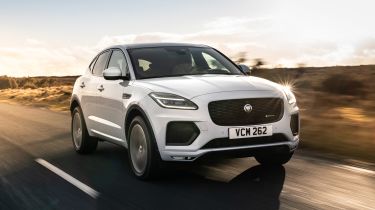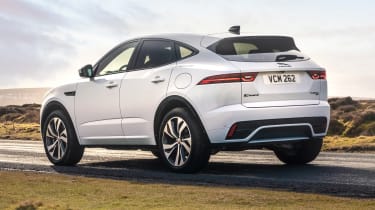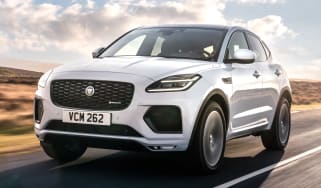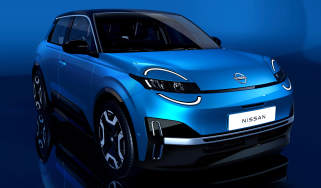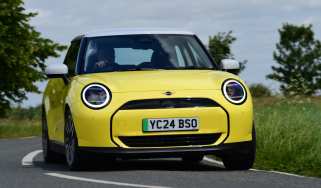Jaguar E-Pace review - Engines, drive & performance (2018-2024)
The Jaguar E-Pace benefits from powerful engines but weight blunts handling
Judged purely as a performance car, the E-Pace isn’t the most engaging or agile to drive, but for a small SUV it’s one of the best in its class. The entry-level front-wheel-drive D165 model is no less agile than its more powerful four-wheel-drive stablemates, but you may miss that extra traction when powering out of sharp corners in slippery conditions. In higher-spec cars, the clever four-wheel-drive system sends more power to the outside rear wheel in sharp bends – effectively helping to push the E-Pace around the corner and boost agility.
The steering has a satisfying weight to it in corners and the nose responds quickly to changes of direction – more so than any rival you care to think of. It feels quite different to the Range Rover Evoque that it shares many of its underpinnings with and its pleasingly weighted steering helps build confidence.
The suspension setup does a great job of keeping the car flat through corners, which makes the E-Pace more enjoyable to drive on a twisty road than the Audi Q3, BMW X1 or Volvo XC60. All models have a JaguarDrive Control system, with configurable settings for steering assistance, gearbox and accelerator response and, where fitted, adaptive dampers. In models without the latter and with a manual gearbox fitted, the settings make no real difference to the overall feel, and you may as well leave it in 'comfort' mode.
Jaguar E-Pace petrol engines
All petrol E-Pace models use powerful 2.0-litre engines and come with four-wheel drive and an automatic gearbox as standard. The entry-level P250 has 246bhp and gets from 0-62mph in 7.5 seconds, while the P300 has 296bhp and is the fastest E-Pace in the range, managing 0-62mph in 6.9 seconds.
Diesel engines
The entry-level diesel is the D165, which uses a 161bhp 2.0-litre diesel engine. It gets the E-Pace from 0-62mph in 10 seconds with front-wheel drive and a manual gearbox. Add four-wheel drive and the 0-62mph time decreases to 9.8 seconds with an automatic gearbox. While this engine will be plenty for some buyers, we’re not sure it fits in with Jaguar’s performance image.
More reviews
In-depth reviews
In manual, front-wheel-drive form, it's an eager-feeling engine and never feels lacking in power, despite the modest on-paper power and acceleration figures. The six-speed manual gearbox is pleasing to use, too, although you have to move the stick quite a long way between gears.
Move up to the D200 and you get the same 2.0-litre diesel engine but with 201bhp. With four-wheel drive and a manual gearbox, the D200 does 0-62mph in 8.4 seconds. This is our pick of the range, with enough performance for most families and the best blend of acceleration, fuel economy and price.
Plug-in hybrid
The P300e is a welcome addition to the range, combining a 1.5-litre three-cylinder petrol engine with an electric motor, serving up a combined 305bhp and 540Nm. This makes it not only the most efficient E-Pace but the most powerful too. Acceleration from 0-62mph takes 6.5 seconds, while its top speed is 134mph.
With all this tech on-board, the E-Pace is no lightweight, but the combined pulling power of the petrol and electric motors means the car feels sprightly off the line, shrugging off its 2.2-tonne weight. Moving off silently adds a sense of upmarket luxury to the driving experience, and the switch between electric and petrol power is impressively smooth. Even when the three-cylinder engine is in use, it doesn't sound too loud or coarse.

